GIF as Documentation / interventions and art in public space


Ygor Marotta and Ceci Soloaga (VJ suave, 2009) are authors of the VJ project Suaveciclos based on audiovisual tricycles that allow them to communicate with the city and people through their drawings.
Tricycles are equipped with a powerful projector, speaker, laptop, batteries. This allows rolling for hours on the streets in front of the ever-changing screen. And the enthusiastic audience follows them on bikes or on foot and watches the special cinema. The project was so far presented in Russia, Germany and Switzerland, and in São Paulo.

Waterfall installation by Ryoichi Kurokawa, Berlin

Kinematope is a site-specific public installation by Pablo Valbuena, developed for Nuit Blanche at the Gare d’Austerlitz in Paris. It animates the pillars of a future train platform of the station, half kilometre long, with timed sequential lighting. “Kinematope is specific twice over. First, for being formulated as a response to the perceptual qualities and inner structure of the place it activates. Second, because its kinematic nature [kinema- : motion (from gr. kínêma); -tope : place (from gr. topos)] is directly connected to the function of the train station itself: transit, transport, motion. Kinematope uses ephemeral and intangible materials, projected light and sound, to set the space in motion. It makes use of elements from the cinema apparatus to generate a spatial film. It is a direct filmic experience that omits the mediation of the camera, transporting the observer into a virtual space-time and maintaining at the same time the real, physical bonds of the body with its environment.”
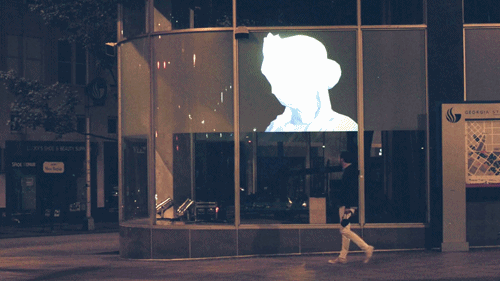
The animation is documented short review of the public interactive installation Between The Two Of These by Brannon Dorsey and Pablo Gnecco. It featured two projected digital forms which disintegrated when people would pass beside it, eventually reforming at opposite ends. It is part of The Window Project at the Digital Arts and Entertainment Lab (DAEL) in Atlanta, GA. “The installation employs infrared cameras to sense motion on location. Movement from the street causes fragmentation and destruction of the projected scene. Between the Two of These creates an active parallel between two present spaces. The constant de/reconstruction of digital representations is an entry point to themes of the temporality of memory and the poetic duality of virtual and physical space. The figures were scanned with the 123D Catch iPhone app. Some were museum busts and some were friends, and family members."

Animation presents art project Database by Tobias Zimmer and David Ebner. It both monitors passers-by with cameras and facial recognition tech, and streams results on printed paper which become shredded. This public installation addresses the subject of surveillance, creating the invisible and unnoticed collection of data in both public and digital spaces, and discussing the use of given information. “The installation consists of a continuous printer, a paper shredder and two cameras, which detect the faces of people passing by. The faces are being printed together with a respective data entry that indicates date, time and number of the capture. They are then going to be processed by the shredder, while the digital image files are deleted immediately upon printing. This way the Database is gradually filling itself with huge amounts of paper and data.”

User 632 is a public installation in public window that stores the behaviour of the people who look at it by monitoring them in return with a Kinect sensor. It notes when and how persons pass by, or whether they stop on the way, storing these data, interpreting them and displaying as real-time statistics. “All data is being tracked and displayed publicly. Passers-by are stored as an anonymous number without any hints to their identities. Whoever comes to close to the camera though will be stored with a photograph next to their id. The installation is made up of three Kinect depth cameras that constantly look for movements which are then reduced to a simple directional line in space. When a visitor enters a specific area, the algorithm is looking for a face. As soon as one is found a countdown appears that shows the time until a photo is taken automatically. At the same time the time a user is in the visible area is stored.”
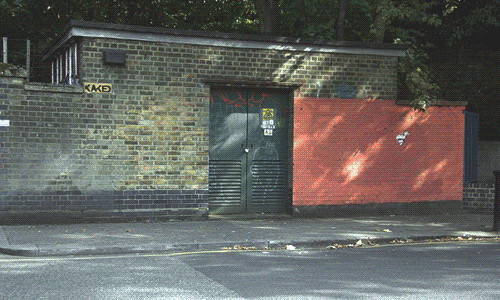
A wall in London, by graffiti artist Mobstr, beginning July 17th, 2014,
and finishing it several months later.

Space Replay is a floating sphere that records and replays the sounds from its surroundings, produced by Francesco Taccini, Julinka Ebhardt and Will Yates-Johnson. It is a hovering object that explores and manipulates transitional public spaces with particular acoustic properties. By constantly recording and replaying these ambient sounds, the levitating sphere produces a delayed echo of human activity. “The sphere responds sonically to people and its surroundings by means of a battery-powered Arduino, an Adafruit Wave Shield hacked to record and playback audio on-the-fly and a small speaker. These were inserted into a latex balloon after being vacuum formed in plastic in the shape of a cone — in order to enhance the sound coming from the speaker and protect the balloon from the wires and PCB edges. A measured amount of helium was added to it in order to be able to lift its content and hover, reaching a neutral buoyant condition. A collaboration with Julinka Ebhardt and Will Yates-Johnson from Design Products, this project is the result of a de-computation brief called ‘Sound object‘. The project, brainchild of IED tutor John Fass, asked how could sonic objects mediate between people, technology and places.”
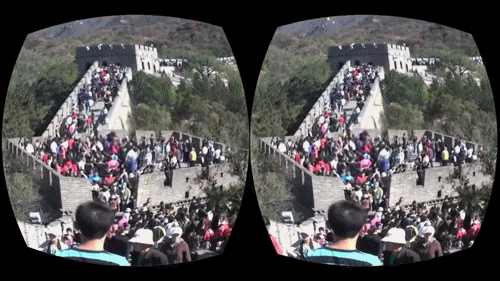
OcuplusGlass is combined AR tour system put together by Sander Veenhof and it employs both a Google Glass and Occulus Rift head for a pair to explore alternative experiences in public spaces. “Where will we be in the world of the future, and how will this world of the future manifest itself? Will we be sitting at home, exploring an Oculus universe constructed by Facebook, or will we be exploring a semi-digital world controlled by Google? While both companies are still engaged in a battle for our eyeballs, when Google Glass and Oculus Rift go hand in end the result is a winning team: OcuplusGlass! Let Google Glass guide you to those spots and trajectories in the city where the physical world matches the virtual experience. A mash-up solving a lot of the disadvantages of each of the devices. If you’re ignoring the world around you and experiencing Oculus content in isolation, at your couch at home, you’re missing something. Finding the world of Glass not that immersive? The OcuplusGlass tours lets both devices do what they can do best, and it adds an element that seems to be absent more and more in the increasingly digital society of today: the human touch. Being guided by a human goes beyond any audiovisual technological feature thinkable.”
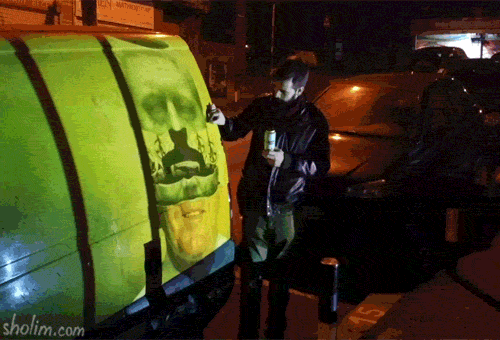
Documentation of Sholim's (Miloš Rajković's) work at Magacin (Kraljevića Marka 8), Belgrade
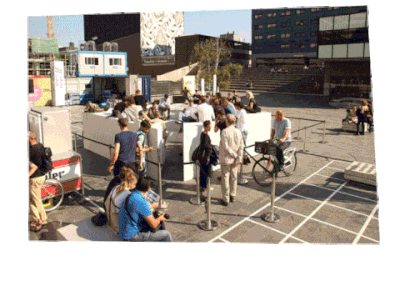
The Politics of Queuing and the Architecture of the Queue is a collaborative work of Marginal, Pablo Calderón Salazar, Rebekka Kiesewetter [Depot Basel], La Jetée, and Parasite 2.0, presented at the TodaysArt Festival 2016, Den Haag.
“The Politics of Queuing and the Architecture of the Queue deals with the spatial, mental, political, economic and social implications of the queue, its taxonomies, preconditions, procedures and the parameters of interdependence between its actors, and it will manifest in a digital research database and in physical interactions with queues. As diverse as the contexts in which queues might take place and as different they might be in shape, there is one aspect unifying (almost) all of them: the act of waiting implies by definition a clear separation and relation of power between the one waiting and the one able to make the waiting end. Queues are always directional – and directed."
"Standing in queues bears the spatial and mental implication of a threshold situation, a physical space of ‘in between’ and in flux, a place of negotiation and for developing agency. It is increasingly dominant spatial phenomenon that presents us with a powerful metaphor for the ambivalence of the Western notion of public space as we encounter it today.”

Sails art installation by Renzo Piano and Alvisi Kirimoto + Partners at Piazza Faber in Tampio Pausania, Sardinia. The installation comprises 12 suspended elements set against a backdrop of historical stone buildings and the market arcade, highlighting the beauty of old Italian towns. The combination of old stone architecture, landscape and colourful installation, creates a new setting which helps relating to the city centre. Source: Designboom

Quiubox is a 2017 project designed in Milan for the Afro-Colombian communities living in the coastal areas surrounding Cartagena. It is a nomadic workshop aiming to tackle inequality by building bridges between professionals and ethnic communities. The modular structure constructed out of CNC-machined plywood panels is a floating platform able to move along the coast, from island to island, in the mangroves, and in the river communities. The architects estimate that more than 40 villages can be reached by Quiubox which would enable knowledge to be shared.
Architects: Tomaso Boano, Jonas Prišmontas, other participants: Marìa Eugenia Beizo, Eszter Hanzséros, Nicola Paggi, Stefano Casati, Wilson Lam. Photographs: Jonas Prišmontas
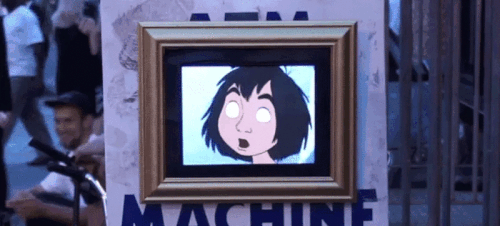
GIFs as street art with artists Guus ter Beek and Tayfun Sarier who mount simple framed LCDs that play endless loops of random animated GIFs all over London in 2014
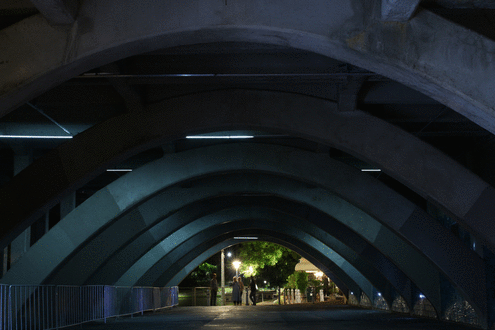
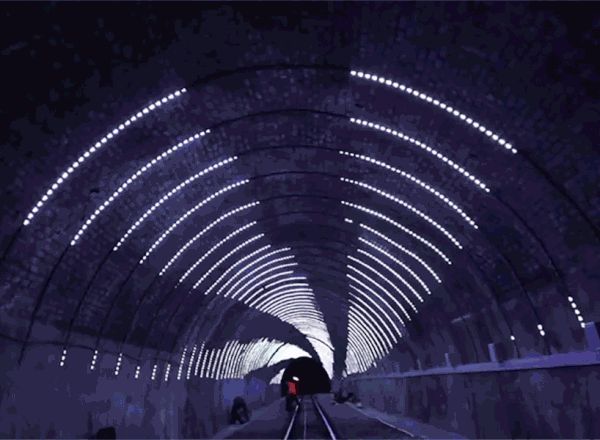
[left] Junction, light motion installation by HC Gilje under the King William Bridge for the Adelaide Festival of the Arts, 2015. Photographs by Paul Armour
[right] In the capital of New Zealand, designer Angus Muir installed a permanent LED lighting installation inside a Wellington tram tunnel
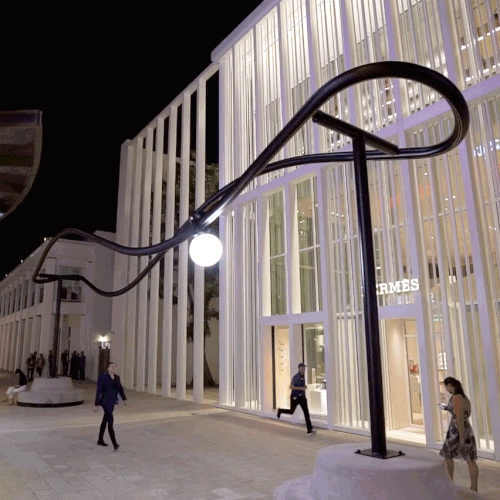
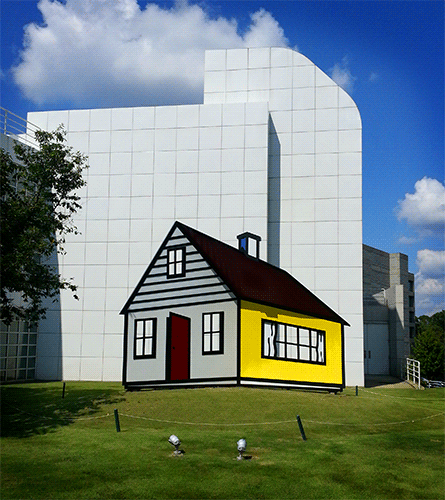
[left] Orbiting light installation by Philippe Malouin within Miami Design District
[right] House III by Roy Lichtenstein, High Museum NY, source: Museum GIFs

Scotland’s Mellerstain’s House and Gardens include two aging structures and a lake that belongs to the estate built in 1725. They were the venue of three art installations, collectively titled XXX, by environmental artist Steven Messam and aim to present a contemporary twist on the marble sculptures that were meant to originally decorate the home’s grounds. Installations are Scattered, on the surface of the lake, Pointed, a protrusion with 28 peaks from the former gatehouse of the estate (on the GIF) and Towered, a series of tubes in the center of an old laundry building
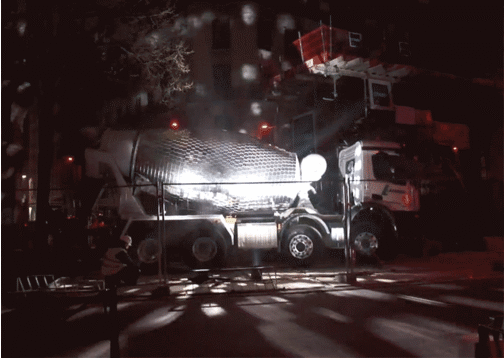
Intervention by Benedetto Bufalino
Addition: GIF after Street Art
i) We Feed, We are Food by A.L. Crego, original photo by Phlegm
ii) INSA's gif-iti

